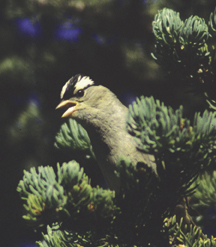To learn a song, young white-crowned sparrows don’t need to hear the entire tune straight through. Hearing it in two-phrase bits will do. If the order of phrases in a pair is reversed—BA and DC instead of AB and CD for instance—the sparrows put together the song in reverse, Gary J. Rose of the University of Utah in Salt Lake City and his colleagues report in the Dec. 9, 2004 Nature. Play the same phrases without pairing them, however, and the young birds end up singing a jumble.

Researchers have known that songbirds need to hear singing very early in life if they’re going to learn songs correctly. Youngsters first babble softly and then sing muddled but more-recognizable song snatches until full adult singing emerges. For years, scientists have been working to tease out the details by which early exposure to song creates a neural template for a lifetime of avian crooning.
Rose and his colleagues created recordings with various combinations of sparrows’ five basic song snippets—single phrases or varying pairs of those snippets, such as DE, CD, BC, and AB. The researchers then played complete but jumbled song versions to nine nestlings that had been brought into the lab while still too young to react to singing. As the birds matured, they pieced together the elements into songs of nearly normal length whose specific melodies depended on the snippets they had heard.
The variation supports the idea that early musical exposure influences combination-sensitive detectors in the birds’ brains, says Rose. Studying how birds learn songs, he suggests, may offer insights into various learning sequences for other movements.






